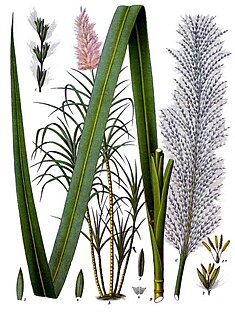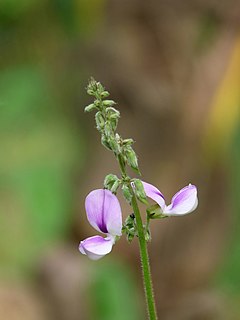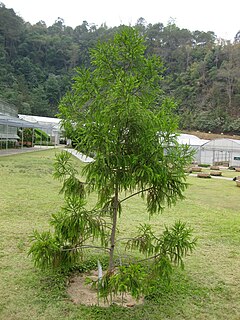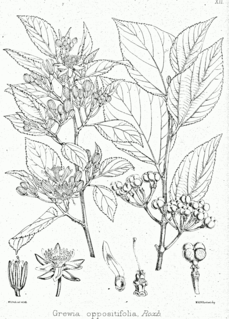
Mangifera is a genus of flowering plants in the cashew family, Anacardiaceae. It contains approximately 69 species, with the best-known being the Common Mango. The center of diversity of the genus is in the Malesian ecoregion of Southeast Asia; particularly in Sumatra, Borneo, and the Malay peninsula. They are generally canopy trees in lowland rainforests, reaching a height of 30–40 m (98–131 ft).

Saccharum is a genus of tall perennial plants of the broomsedge tribe within the grass family.

Curcuma is a genus of plants in the family Zingiberaceae that contains such species as turmeric and Siam tulip. They are native to Southeast Asia, southern China, the Indian Subcontinent, New Guinea and northern Australia. Some species are reportedly naturalized in other warm parts of the world such as tropical Africa, Central America, Florida, and various islands of the Pacific, Indian and Atlantic Oceans. Generally, most curcuma grows well in loose and sandy soil in shaded areas.

Pueraria is a genus of 15–20 species of legumes native to Asia. The best known member is kudzu, also called Japanese arrowroot. The genus is named after 19th century Swiss botanist Marc Nicolas Puerari.

The Combretaceae, often called the white mangrove family, are a family of flowering plants in the order Myrtales. The family includes about 530 species of trees, shrubs, and lianas in ca 10 genera. The family includes the leadwood tree, Combretum imberbe. Three genera, Conocarpus, Laguncularia, and Lumnitzera, grow in mangrove habitats (mangals). The Combretaceae are widespread in the subtropics and tropics. Some members of this family produce useful construction timber, such as idigbo from Terminalia ivorensis. The commonly cultivated Quisqualis indica is now placed in the genus Combretum. Many plants in the Quisqualis species contain the Non-proteinogenic amino acid excitotoxin Quisqualic acid, a potent AMPA agonist.

Terminalia is a genus of large trees of the flowering plant family Combretaceae, comprising nearly 300 species distributed in tropical regions of the world. The genus name derives from the Latin word terminus, referring to the fact that the leaves appear at the very tips of the shoots.

Monstera is a genus of 59 species of flowering plants in the arum family, Araceae, native to tropical regions of the Americas.

Staphyleaceae is a small family of flowering plants in the order Crossosomatales, native to Europe, temperate and tropical Asia and the Americas. The largest genus Staphylea, which gives the family its name, contains the "bladdernut" trees. The family includes three genera with more than 40 known species.

Pandanus amaryllifolius is a tropical plant in the Pandanus (screwpine) genus, which is commonly known as pandan. It has fragrant leaves which are used widely for flavouring in the cuisines of Southeast Asia and South Asia.

Dacrydium elatum is a species of conifer in the family Podocarpaceae. It is found in Cambodia, Indonesia, Laos, Malaysia, Thailand, and Vietnam.

Hopea is a genus of plants in the family Dipterocarpaceae. The genus was named after John Hope, 1725–1786, the first Regius Keeper of the Royal Botanic Garden, Edinburgh. It contains some 113 species, distributed from Sri Lanka and southern India to southern China, and southward throughout Malesia to New Guinea. They are mainly main and subcanopy trees of lowland rainforest, but some species can become also emergent trees, such as Hopea nutans.

Uvaria is a genus of flowering plants in the family Annonaceae. The generic name uvaria is derived from the Latin uva meaning grape, likely because the edible fruit of some species in the genus resemble grapes.

Jean Baptiste Louis Pierre, also known as J. B. Louis Pierre, was a French botanist known for his Asian studies.

Ficus palmata, the Punjab fig, or "Bedu" is a plant in the family Moraceae.
Thepparatia is a monotypic genus of flowering plants belonging to the family Malvaceae. It only contains one known species, Thepparatia scandens(Roxb. ex G.Don) Phuph.
Naringi is a genus of flowering plants belonging to the family Rutaceae.
Gonostegia is a genus of flowering plants belonging to the family Urticaceae.

Grewia oppositifolia is a currently accepted species of flowering plant in the family Malvaceae, native to the Indian Subcontinent. It has many similarities with and may be a synonym of Grewia optiva ; certainly they share the same range, habitat, appearance, growth form, common names, and local uses as a source of forage, timber, fruit, and medicine.

Erythrina suberosa, the corky coral tree, is a species of flowering plant in the family Fabaceae. It is native to the Indian Subcontinent, Southeast Asia, and Peninsular Malaysia. Due to its showy flowers and habit of flowering most of the year, it is often planted as an ornamental or street tree. Although the flowers can be used to make a refreshing drink, the seeds are poisonous.
Elaeagnus triflora is a climbing plant of the family Elaeagnaceae. Its native range encompasses Taiwan, Malesia, and the Australian state of Queensland. Its fruit is considered bush tucker in Australia.















